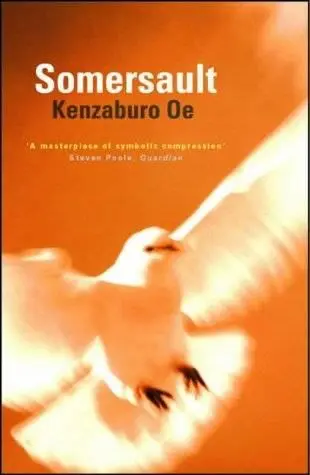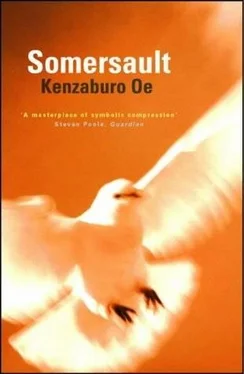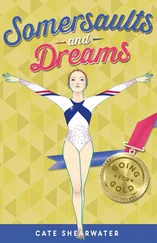
Translated from the Japanese by Philip Gabriel
BEAUTIFUL EYES IN A DOGLIKE FACE
A small figure was making its way forward-a man, it appeared, with ex- traordinarily well-developed muscles yet reduced in scale. Chest thrust out, he advanced into the gloom, clutching in his outstretched arms a structure made of two boomerang-shaped wings, one on top of the other. Narrow ban- ners hung down in front of him; beyond that was a brightly lighted stage. Just as he bent down to pass by a switchboard that jutted out into the passageway, one tip of the wing of the structure plunged under the tutu of a dancer who was hurrying past.
The small man and the young dancer froze. The girl, bent forward, shifted her weight to her right leg, leaving her wide-open left leg defenseless, elevated in midair, yet somehow she was able to keep her balance. She glared at the small man, her anger evident at having been forced into this helpless position. Her little face turned bright red, like a sunlit plum. But what looked back at her wasn't a small man. It was a boy-forehead, mouth, and ears pro- truding like those of a dog-yet with a strangely beautiful gaze.
The boy looked at her for the briefest of moments. In order to rescue the structure he supported in his outthrust arms, the boy tried to lift it up above the framework sticking out from the wall to his left, twisting the joint con- necting the two wings in an attempt to slide one half upward. For her part, the girl, through her billowed-out skirt, shifted the structure toward her ab- domen to absorb some of its weight, all the while keeping her left foot raised and balancing on the right one. From in front and behind the unfortunate pair, men in black leaned forward and jostled one another. At that instant, a flash of determination swept across the boy's doglike face and he flung his structure straight down, scattering hundreds of multicolored plastic pieces.
Now free, the girl pressed down her bell-shaped skirt and flew off in tears to join the group of dancers beside the stage.
The young boy pushed forward with his narrow yet strong shoulders, shoving aside the taller black-suited men. Like a very small model of some- one who's just completed a grand project, he strode off into the dark of the passage behind the stage, a dignified exit undeterred by the shouts of the men.
The dance troupe members halfheartedly consoled the girl, who was late, but they were concerned with their own costumes, and, besides, they'd missed their big chance that day to appear. The young boy, favored to receive the grand prize in the awards ceremony, had smashed to bits both his creation and any reason for him to make an appearance and had now disappeared.
Did destroying the model city he'd taken a year to create afford him a precocious, lawless sense of confidence-this boy who often fled from the center of Tokyo? Did seeing his creation as something whose sole purpose was to be broken to pieces make him wonder if even this huge metropolis could be razed if one wanted it to? But to what end? He had no idea, but there was plenty of time in life to try to answer that, or at least to formulate the question. This dog-faced boy, with his combination of breathtaking ugliness and beauty, must have been convinced of this, deep inside his still-forming body.
This episode took place at a public exhibition of imaginary landscapes of the future created from small plastic blocks, an event sponsored jointly by an American educational materials company and a Japanese firm that imported stationery supplies. In later years, Kizu, who had been on the screening com- mittee, often recalled the boy who had arrogantly removed himself from the competition. Kizu could never forget how, when he first saw the boy at the exhibition, the word child didn't come to mind, but rather the term small man.
He recalled the boy's moment-to-moment movements and expressions-at once so ugly you could barely bring yourself to watch, yet so lovely you felt your chest constrict-and the extraordinary vitality evident behind them.
Because he was a painter, it was second nature to Kizu to want to scrutinize, over time, the details of the object of his gaze, so he was struck by a desire to watch each stage of development of this strangely compelling little lump of a child: childhood, adolescence, and youth. He felt sure that someday he'd be able to do this yet equally certain it would never happen, for even when the boy was right in front of his eyes, it had all felt like a dream… The autumn when the exhibition was held had marked a new start in Kizu's life. Already in his late thirties, his major accomplishment was to be short-listed for the Yasui Prize, but he had actually won several awards, which had led to talk of a "Kizu style" being mentioned in the same breath as that of the work of an artist who specialized in reproductions of classic paintings, the kind found hanging in European galleries. Even so, some people still con- tinued to compare Kizu's painting with the American Urban School, which led to his receiving a Fulbright to study at an American university on the East Coast well known in the field of art education. As with the majority of Japa- nese artists, this should have been nothing more than a simple rite of passage, but Kizu was genuinely interested in art education methods, and, in his typically intense and focused way he decided to go back to graduate school. This took five years, during which he divorced the wife he'd left behind in Japan.
Now, several years later and PhD in hand, Kizu decided to say goodbye to life in the States and return to Japan.
Kizu had been asked to join the selection committee by its head, who'd been delegated the job by the corporate headquarters of the American company; the man had helped Kizu both during his Fulbright stay and after he extended it, and Kizu naturally felt obligated to him.
The creation the dog-faced boy came up with at the contest was amazingly inventive, yet what affected Kizu most was what radiated not from the work but from the boy's looks and attitude-his entire being. It pained Kizu to realize that he himself lacked the archetypal aura the boy possessed. Even when he was living in America he'd felt his style of painting had reached a dead end, a feeling that surfaced in the conviction that he had no ground to stand on as an artist.
After an assistant professor in Kizu's department at the American university failed to receive tenure and moved on to another institution, Kizu's mentor invited him to take the departed man's position. Kizu had spiritedly given up on having a career as an artist in his own country-a move spurred on by the deeds of that small man-so he accepted the mentor's invitation and returned to live more or less permanently in the United States. Kizu went on to spend the next fifteen years in the states on the East Coast, receiving ten- ure along the way. As part of academic life, Kizu had taken sabbaticals, and now for the first time he chose Japan for his sabbatical leave. An urgent reason lay behind this choice. Four years before, he had been operated on for colon cancer. The examinations and surgery he'd undergone after the first symptoms appeared were almost unbearable. What's more, his elder brother had undergone surgery for the same condition before Kizu; two years ago the disease had spread to his liver, and after one awful operation followed an- other, he passed away. Even though he felt unwell himself, Kizu refused to he examined further.
The previous autumn at a dinner party at his university's research institute, an oncologist of note commented that Kizu didn't look at all well and recommended he get a thorough checkup; he gave in to the sense of resignation he'd long held inside and had the doctor write a letter of introduction for him to a former student who ran his own clinic in Tokyo. Sick as he knew he was with cancer, though, the last thing Kizu wanted was any more pain- ful poking and probing or operations.
Читать дальше






